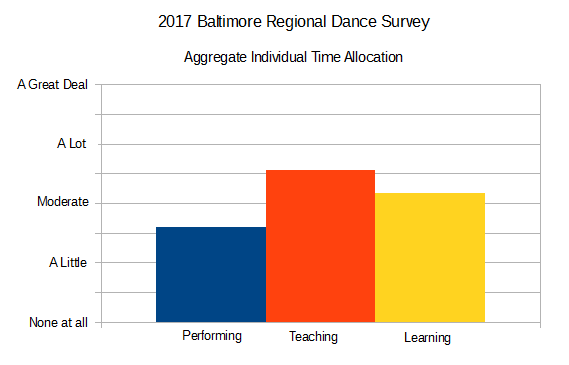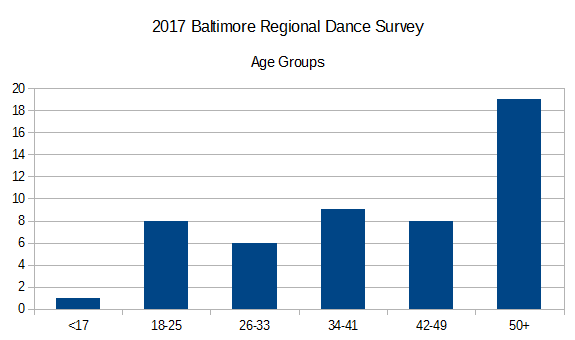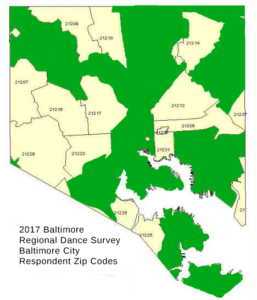I just received the dataset from the first Baltimore Regional Dance Survey, and I want to thank everyone that participated, and in particular, the Towson students (Naomi Butler, Matthew Losover, and Odunola Oduwole) that conducted the survey as part of their classwork, their instructor (Philippe Duverger), and Cheryl Goodman of Dance Baltimore for helping distribute the survey. It’s going to take some time to fully appreciate the data available, but I did want to tease everyone a bit with the scope of dance in Baltimore.
This survey was sent to 752 potential respondents (plus Dance Baltimore?), 53 completed the entire survey with another 106 partial responses. For now, I’m arbitrarily excluding responses that completed less than 10% of the questions and any responses that spent less than 2 minutes total engaged in the survey (the first few questions from incomplete responses might come back in a future analysis). This leaves 80 responses for analysis, or just a bit more than 10% response rate. Obviously, I’d like to see greater participation, but as a first attempt, I think this is a good start. There are some obvious biases, which I hope to address in time. Of particular concern, there was very little participation from the beginners and casual dancers in the area. Respondents are very biased toward professionals, educators, and those with long careers in dance, but I really (REALLY!) do want to hear from the full array of dancers in the region. For those that did not participate, the survey was structured to analyze four key segments of the Baltimore dance economy – performers, instructors, students, and suppliers of services to dancers.
With that introduction, let’s look at some very superficial numbers (and make up a new unit in the process, the form-year). Self-identified Performers, Instructors, and Students were asked to indicate how many years of experience they had in each of many dance forms (broadly categorized). Based on those responses, this dataset represents at least, 4125 FORM-YEARS of performance experience (the most popular performance dance forms representing 848 years of Modern/Contemporary, 713 years of Ballet, 522 years of Jazz, 317 years of Lyrical, and 287 years of Tap), at least 2827 FORM-YEARS of dance teaching experience (the most popular teaching dance forms representing 551 years of Modern/Contemporary, 447 years of Ballet, 317 years of Jazz, 309 years of Tap, and 234 years of Lyrical), and 4331 FORM-YEARS of dance class experience (the most popular dance forms represent 872 years of Ballet, 822 years of Modern/Contemporary, 555 years of Jazz, 499 years of Tap, and 317 years of Lyrical). These respondents report an average aggregate learning experience of 54.1 form-years, an average aggregate performance experience of 51.5 form-years, and an average aggregate teaching experience of 35.3 form-years.
The last question was open-ended – “Please describe any other issues that affect dancers or dance development in Baltimore Area” Because I can’t respond directly to follow up for more detail or information, I’ll leave some interesting comments here in the hope that they will prompt some discussion or the original respondent will reach out… I’ll start with some questions and hopefully others will jump in with comments.
There is not enough of the art scene in general in Baltimore and sometimes you have to travel in unsafe areas.
I’m sure anyone that’s spent any time with me in a production setting knows that safety (in general) is kind of a thing in my world, but more interesting in this comment is the art scene in Baltimore – is there something more specific missing for you?
Finding affordable choreographic opportunities.
Can you be more specific? Are venues unaffordable? Performers? Equipment? Something else?
I would like to see more open classes for adults/professionals without the commitment to a company.
and
very little classes beyond beginning ballet are available for adult dancers.
and
Finding professional level classes after graduating from college and dance companies in MD
I couldn’t find an sort of industry-standard definitions for things like “open classes” so the survey actually defines four levels of classes –
- Masterclass – taught for a limited time or on an irregular basis by a visiting or unique instructor.
- Advanced – taught on a regular basis by local instructors, generally requiring specific dance competency prerequisites, instructor placement, or audition.
- Intermediate – taught on a regular basis by local instructors, and open to students with general dance background.
-
Beginner – open to all students of any background or experience.
Which ones are missing? In what dance forms? At what price?
Veteran Black Non-classical dancers/ dance instructors do not get as many open doors and compensation for sharing and showcasing their creative talents and genius in venues in Baltimore, as their Caucasian counterparts.
This one has deep roots, but is there a specific way to address the problem?
Theaters that can be afforded have poor lighting and sound.
Short-term, is your preferred answer to increase what you can afford, or to provide better lighting and sound in existing theaters?
So with that, I welcome your comments below…
[Update: Posts about the survey will be in the “BRDS” category, click that to see all of them]





